Written collaboratively by Xufei Yang, Robert Thaler, Ryan Samuel and Richard Nicolai.
Introduction
Livestock and poultry producers continually face economical and time restraint challenges. They seek a lifestyle that does not demand 10 to 16 hours of labor each day. As a result, producers have expanded and concentrated their operations in recent years to make the operation more efficient and bring in additional labor to share the workload. However, this expansion has also resulted in a community concern about emissions of air pollutants, especially odorants. Because of this concern, there has been an increase in complaints towards animal production facilities.
To address these concerns between livestock production facilities and community residences, local regulators establish minimum setback (separation) distances through local zoning and/or state regulatory procedures. Unfortunately, very few of these setback requirements have a scientific basis because the science did not exist and decisions by local officials were based on empirical rules or emotions.
To provide the needed science, air quality researchers at South Dakota State University, University of Nebraska, and University of Minnesota developed the South Dakota Odor Footprint Tool (SDOFT) for estimating odor impacts from livestock and poultry facilities to the surrounding community. These estimates are useful for local government land-use planners and citizens concerned about the odor impact of existing, expanding, or new animal production sites.
The SDOFT involves a two-step procedure. Step 1 estimates the average emissions from a variety of animal facilities and manure storages. This estimate is based on odor measurements from livestock and poultry farms in the upper Midwest. Step 2 estimates the atmospheric dispersion of the emissions from the site. This dispersion is simulated based on AERMOD, an Environmental Protection Agency (EPA) approved air dispersion model using South Dakota climatic conditions.
The SDOFT results provide rural communities and local government officials with the information needed to incorporate science and objectivity into the permitting process. They decide what levels of odors are acceptable and then determine the consequence of the “acceptance” level. Also, the tool provides the livestock producers with science-based information that can be used to properly site livestock facilities.
